Sep 03, 2021 Start the School Year Off With Strategies to Build Community and Enhance Engagement and Ownership of Learning
Taking the time to welcome students back to school and help them build a positive and productive learning community is more important now than ever before. Over the past month, I have been working with schools across the country who are intentionally building in more focused time for advisory, morning meeting, and school-wide relationship building efforts as students and staff re-enter school, many for the first time in eighteen months. Along with ideas for school-wide community building, I offer educators practical ways to integrate community building and social and emotional learning (SEL) into day-to-day academic work. Here are some of the “tried and true” strategies that I share with educators to meaningfully engage students of all ages in group building, academics, and SEL as they kick-off the new school year:
Hooks to Engage and Welcoming Rituals
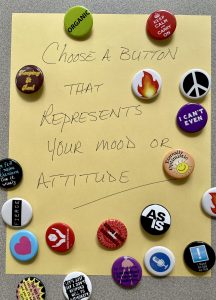 The first few minutes of an experience or lesson are a key time to hook and engage learners, create context for learning, and set a positive and welcoming tone. A novel activity engages learners right away, drawing them into a positive experience and creating buy-in. Learners of all ages come to the classroom with things on their mind— a stressful commute, a rough morning at home, a negative social interaction in the hallway before class, or the exam coming up next period. A reflective, focusing activity can help learners transition into the classroom space and shift their focus to the present and the lesson at hand. Research on learning and retention shows that people remember most about the first few minutes of an experience, and secondly the last few minutes of experiences (Willis, 2014). Cognitive neuroscientists call this the primacy-recency effect. John Medina, author of Brain Rules, states: “If you are trying to get information across to someone, your ability to create a compelling introduction may be the most important single factor in the later success of your mission” (2008, p. 116). This information validates the importance of welcoming learners of all ages with an engaging opening activity and providing a meaningful reflection prompt to tie it all together or “bookend” a learning experience. I like the language around this practice I’ve seen promoted by leaders in Social and Emotional Learning such as Austin Independent School District’s SEL department who use the terms “welcoming ritual” and “optimistic ending” to describe this practice of intentionally infusing welcoming and closing rituals into class and group sessions. This might seem like a lot to plan at first, but I find it becomes a rewarding part of each day and a positive habit that students will help you facilitate. Here are some examples:
The first few minutes of an experience or lesson are a key time to hook and engage learners, create context for learning, and set a positive and welcoming tone. A novel activity engages learners right away, drawing them into a positive experience and creating buy-in. Learners of all ages come to the classroom with things on their mind— a stressful commute, a rough morning at home, a negative social interaction in the hallway before class, or the exam coming up next period. A reflective, focusing activity can help learners transition into the classroom space and shift their focus to the present and the lesson at hand. Research on learning and retention shows that people remember most about the first few minutes of an experience, and secondly the last few minutes of experiences (Willis, 2014). Cognitive neuroscientists call this the primacy-recency effect. John Medina, author of Brain Rules, states: “If you are trying to get information across to someone, your ability to create a compelling introduction may be the most important single factor in the later success of your mission” (2008, p. 116). This information validates the importance of welcoming learners of all ages with an engaging opening activity and providing a meaningful reflection prompt to tie it all together or “bookend” a learning experience. I like the language around this practice I’ve seen promoted by leaders in Social and Emotional Learning such as Austin Independent School District’s SEL department who use the terms “welcoming ritual” and “optimistic ending” to describe this practice of intentionally infusing welcoming and closing rituals into class and group sessions. This might seem like a lot to plan at first, but I find it becomes a rewarding part of each day and a positive habit that students will help you facilitate. Here are some examples:
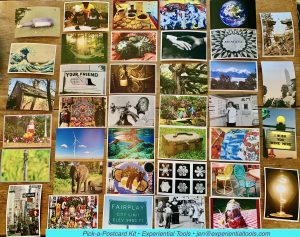 Postcards, Images, and Object “Hooks”:
Postcards, Images, and Object “Hooks”:
My favorite methods for engaging and welcoming learners from the moment they walk in the door involve the use of object or image-based reflection prompts such as postcards, paint chips, computer keyboard keys, Miniature Metaphors, tools, and other found objects, natural objects, and household items. People are drawn in by colorful, novel, or intriguing imagery and objects and often reflect and share more readily when they can attach their thoughts and feelings to an item that can be touched and shown to a group during discussion, or described in reflective writing. Brain research suggests that using metaphors, pictures and symbols helps cement lessons and transfer learning to everyday life and future learning (Willis, 2010). Visit these links to read more about using postcards, images, and objects as a welcoming strategy including some prompt examples.
Quotes, Pin-Back Buttons, and Compelling Questions:
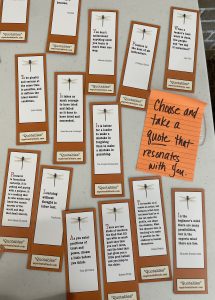 Quotes: Opening a class/session by offering a variety of quotes with a context or theme related to your lesson or group goal is a powerful way to engage, create context and “frame”or “anchor” a lesson or upcoming experience by creating relevancy and emotional connection to the content. Quotes are an engaging transitional, introductory, or reflective activity and a compelling way to explore an academic subject or discussion topic. Discussing quotes can help group members connect with each other or spark creative thought around a subject. To read more examples of the use of quotes check out this post from the blog archives.For quotes centered around the theme of experiential learning see my Quotables collection.
Quotes: Opening a class/session by offering a variety of quotes with a context or theme related to your lesson or group goal is a powerful way to engage, create context and “frame”or “anchor” a lesson or upcoming experience by creating relevancy and emotional connection to the content. Quotes are an engaging transitional, introductory, or reflective activity and a compelling way to explore an academic subject or discussion topic. Discussing quotes can help group members connect with each other or spark creative thought around a subject. To read more examples of the use of quotes check out this post from the blog archives.For quotes centered around the theme of experiential learning see my Quotables collection.
Simply posing a brain-teaser, word puzzle or reflective prompt to think or talk about as student’s enter can be an easy to-plan welcoming/focus strategy. Tools like Table Topics and Chat Pack cards are useful resources for these kinds of question prompts and can be found at your local independent bookstore. When using question prompts, I infuse choice into the activity by displaying an assortment of questions and inviting participants to choose a question they would like to chat about with partner rather than handing questions out or having them blindly receive a question.
Conversation Starter Buttons or Paint Chips
Conversation-Starter Buttons or paint chips/samples are a fun and easy way to transition into a classroom 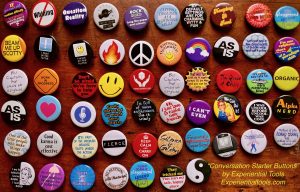 or workshop space. They are a perennial favorite in my professional development and adult learning programs, and I regularly use them with middle and high school students as a way to check in on progress around group projects. This is also a tried-and-true activity for engaging educators or college leaders in laughter and dialogue during a professional development session. The buttons bring humor into group settings where individuals are reluctant to participate, helping them buy-into the group process. If you don’t have access to the buttons, paint chips can be used similarly.
or workshop space. They are a perennial favorite in my professional development and adult learning programs, and I regularly use them with middle and high school students as a way to check in on progress around group projects. This is also a tried-and-true activity for engaging educators or college leaders in laughter and dialogue during a professional development session. The buttons bring humor into group settings where individuals are reluctant to participate, helping them buy-into the group process. If you don’t have access to the buttons, paint chips can be used similarly.  I choose paint samples from my local hardware store based on the paint name as well as color.
I choose paint samples from my local hardware store based on the paint name as well as color.
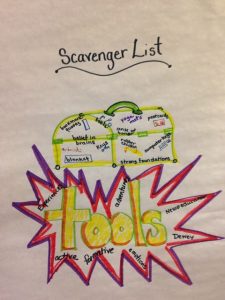 Graffiti Wall, Group Drawing, or Sculpture
Graffiti Wall, Group Drawing, or Sculpture
There is great power when learners create symbols, music, words or performance to represent feelings and experiences. The very essence of art is expressing oneself. Throughout history, humans have used artistic expression to explore, understand, and share ideas and experiences. Involvement in individual/group art activities can be a rich, reflective process for participants. My favorite collaborative artistic methods that are engaging warm-up, entry or ongoing reflection activities include Group Drawing/Sculpture and Graffiti Wall.
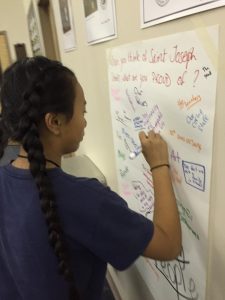 Gallery Walk
Gallery Walk
I use Gallery Walk when I want to engage a group in reflecting on group norms or goals, gather information on experiences, opinions and questions from group members. It is a simple and effective method for getting a group moving, reflecting and staying engaged in a topic and making sure everyone’s voice is represented. It is a helpful technique for generating a list of group input on a subject, such as solutions, goals, questions, to use as a reference later in the groups experience. It works well as an entry, reflection or transition activity that could be done over time. 2014 Gallery Walk Post from the Inspired Educator Blog.
Taking the time to create a welcoming ritual, first five, or hook activity to start a school day or class session creates an opportunity for participants to make positive connections with their peers, set up context around the upcoming experience or lesson, begin the process of reflection, and shift students focus to the here and now. I consider it an essential engagement tool that reaps great rewards for SEL skills development and ongoing reflection and engagement in content. For more ideas check out chapter 5 of the Inspired Educator, Inspired Learner book or this recent post from the Inspired Educator Blog.
Building Connections through Pair and Small Group Active Engagement and Dialogue Activities
Start the group with simpler activities that aren’t overly silly or performance oriented. Include choices about the level of participation. By building trust in this way, group members start to share and engage at their own pace and become more willing to push their comfort zones later on when it really matters. Rather than opening a program with a whole circle introduction I begin rapport building and reflective dialogue with partner or small group sharing activities and start with simple, non-threatening — but relevant, context setting– questions or an object/picture/quote to use as a talking point. This allows participants an opportunity to warm up by interacting with just one or two others at a time before sharing with the larger group.
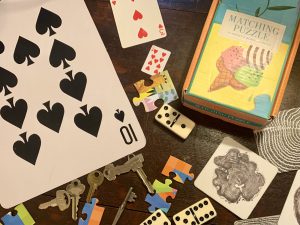 Pair Share/Groupings Activities
Pair Share/Groupings Activities
Objects like dominoes, match game cards, playing cards can draw participants into an experience. Using a prop based activity as a tool to help participants first find partners or small groups for partner activities and sharing is not only engaging, but it facilitates a sense of comfort and choice and control within these initial warm-up activities. People have something physical that they can use as a tool for connection. I always allow for choice in interpreting what matching means so there will be options for finding a partner based on each persons comfort level. It also models from the beginnig that there will be many answers, possibilities and options in the upcoming group experience and that the group are partners in facilitating, teaching and learning. Check out these articles for more examples including some no-prop options:
“Keys” to Success (Repurposing Housekeys for Partnering and Reflection Article).
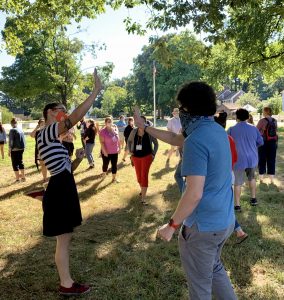 “Air Handshakes Mingle” and “Concentric Circles at a Distance”
“Air Handshakes Mingle” and “Concentric Circles at a Distance”
Rather than opening a program or class with a whole circle introduction I always begin rapport building and reflective dialogue with partner or small group sharing activities and blend in simple, non-threatening — but relevant, context setting– questions or an object/picture/quote to use as a talking point. This allows participants an opportunity to warm up by interacting with just one or two others at a time before sharing with the larger group. This incremental building of connections one or two people at time rather than beginning as a whole classroom or whole group “sharing circle” helps learners build comfort with each other and the group process, and honors the introverts, leading to more engagement, buy-in, and in-depth reflection discussions later on.
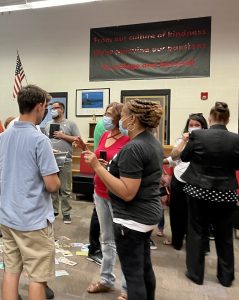 Commonalities Mingle
Commonalities Mingle
Commonalities Mingle is an engaging activity for building rapport in groups of all kinds. It is also a useful method to collectively reflect on group norms, and group goals. It can be an engaging way to review and reflect upon academic or training material while at the same time learning about peers or colleagues and exploring common and differing perspectives on a topic. It is a effective community builder for advisory groups and morning meetings. For team-building and networking programs it can facilitate the understanding of “who is in the room” and help participants make connections and start a dialogue about reflection topics. Check out this post from the Inspired Educator Blog with more details: Commonalities Mingle Activity for Rapport-Building Reflection Positive-Group-Norms and Academic Review & Discussion.
Why Names are Important and How to Honor Them
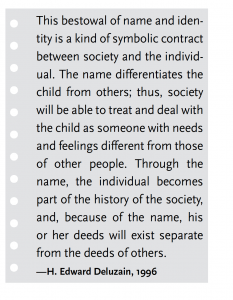 A key ingredient for creating a positive and productive environment for learning is to help participants and teachers/leaders know and use each other’s names correctly from the very beginning of the school year or program. Dr. Angela M. Ward is a thought leader I admire in the education world who offers transformative resources for promoting equity in education. She emphasizes how important it is for teachers to make the effort to learn and correctly pronounce the names of their students because of the powerful role they play in the positive identity development of each student in their care. Even in the small schools I encounter in rural areas — where educators might assume students already know each others’ names — many actually don’t or are not always using and honoring names in a respectful way. I have found the same to be true with adults in the workplace.
A key ingredient for creating a positive and productive environment for learning is to help participants and teachers/leaders know and use each other’s names correctly from the very beginning of the school year or program. Dr. Angela M. Ward is a thought leader I admire in the education world who offers transformative resources for promoting equity in education. She emphasizes how important it is for teachers to make the effort to learn and correctly pronounce the names of their students because of the powerful role they play in the positive identity development of each student in their care. Even in the small schools I encounter in rural areas — where educators might assume students already know each others’ names — many actually don’t or are not always using and honoring names in a respectful way. I have found the same to be true with adults in the workplace.
Given names represent choice, thoughts, and feeling on the part of the individual’s family members. Preferred nicknames or new or shortened names chosen by the individual represent a personal sense of self, choice, control, and ownership. Honoring this sense of identity and choice promotes dignity, respect, and positive group culture. Carefully curated and facilitated activities help groups of all ages practice names and explore the concepts of connecting with others, honoring their peer’s strengths and personalities, and showing respect for individualism, identity, and choice. The following are a few of my tried and true activities to help groups learn, practice, and reinforce names in a meaningful, but playful, non-threatening, and palatable way. Check out this post for more on “Name Meanings” and a few thoughtfully sequenced name activities.
Team Tally
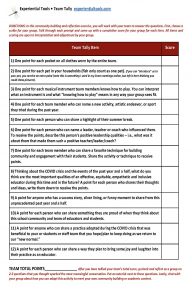 Team Tally is my go-to community building, reflection, and review activity for groups of various ages, situations, and sizes and perfect for group building at the start of a school year. Team Tally is a powerful reflection and relationships building activity because it blends the right amount of healthy competition to draw participants in, and if thoughtfully designed, carefully sequenced questions will keep them sharing in a non-threatening, collaborative atmosphere. A thoughtful educator or facilitator can create context, blend in targeted review, reflection, and data gathering questions around specific content, themes, or topics.
Team Tally is my go-to community building, reflection, and review activity for groups of various ages, situations, and sizes and perfect for group building at the start of a school year. Team Tally is a powerful reflection and relationships building activity because it blends the right amount of healthy competition to draw participants in, and if thoughtfully designed, carefully sequenced questions will keep them sharing in a non-threatening, collaborative atmosphere. A thoughtful educator or facilitator can create context, blend in targeted review, reflection, and data gathering questions around specific content, themes, or topics.
Because it is participant-directed, it is ideal for transitional times, i.e., when returning from a break, mealtimes. It is also useful when an unexpected change in a schedule occurs, and you need a self-directed activity to engage the group in while you adjust materials or set up. You can adapt the questions to fit the group and situation and always infuse opportunities for choice and ownership by weaving in flexibility as to how the questions are worded. Competition initially draws the group in, but it’s the choice-centered group sharing, collaboration, and relationship building that keeps them engaged. Check out this Article from the Inspired Educator Blog “Team Tally, the Activity I Always Have in My Bag of Tricks” Email me at jen@experientialtools.com for example templates you can adapt to your own groups.
Other Favorites for Integrating Academics, Community Building and SEL
Make the most of your time by integrating academic content with group-building, problem-solving, and social-emotional skills development. Learners can practice, review, synthesize, and discuss academic material through playful collaborative learning. Proponents of experiential education promote the importance of active, as well as intellectual, engagement in learning along with the value of reflection. Educational neuroscientists’ studies reveal that play facilitates learning and that educators can enhance outcomes by using interactive approaches and multiple senses to create multiple pathways to learning.Play Doh Pictionary, Charades Race, Bag of Nouns, and Domino Fraction Line Up are some of my “tried and true” favorite activities for integrating academic or training content review and reflection with community building and social and emotional learning.
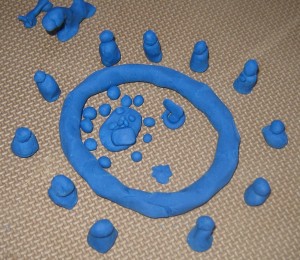 Play Dough Pictionary
Play Dough Pictionary
Play dough pictionary works well for concrete concepts like geographic features, parts of a cell, technical equipment review, geometry etc. 2012 Inspired Educator Blog: Play Dough Pictionary Activity Post
Charades Race
Charades Race is an engaging way to review more abstract concepts such as characters in a book, events, or theoretical ideas, or, to reflect on highlights of a shared experience. Charades Race for Review and Formative Assessment
Here is an article on online versions of these activities: Charades Race and Playdough Pictionary Online
Bag of Nouns
Many of the inspired educators that I work with have shared variations of this playful party game for active review and formative assessment in the classroom or training sessions. Bag of Nouns for Review and Formative Assessment and Fun!
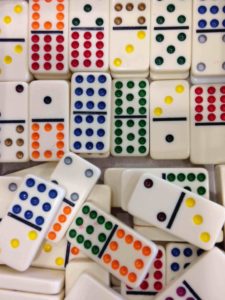 Domino Fraction Line Up
Domino Fraction Line Up
Domino Fraction Line Up An Accidental Success in the Classroom
Anyone Who for Reflection and Review
An adapted version of the well-known ice-breaker Have You Ever, repurposed for review, formative assessment and reflection: 2011 Inspired Educator Blog: Another Idea to Get Them Moving and Keep Them Engaged Anyone Who
Harnessing the Power of Play to Teach
Harnessing the Power of Play to Teach (Article on the Why Behind Using Play to Teach)
Please reach out to me at jen@experientialtools.com for ideas for a specific age group or theme, questions, or support in planning for an upcoming class or group experience.
References:
Medina, John. (2008, 2014). Brain Rules: 12 Principles for Surviving and Thriving at Work, Home and School. Seattle, WA: Pear Press.
Stanchfield, Jennifer (2014). Inspired Educator, Inspired Learner: Experiential, Brain-Based Activities and Strategies to Engage, Motivate, Build Community and Create Lasting Lessons. Bethany, Ok: Wood N Barnes Publishing
Stanchfield, Jennifer (2016) Tips & Tools for the Art of Experiential Group Facilitation. Second Edition. Bethany, Ok: Wood N Barnes Publishing
Willis, J. (2014) “Brain-based teaching at The Learning & the Brain Conference: Engaging 21st Century Minds. Boston, MA. John Medina



No Comments